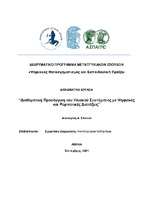| dc.contributor.advisor | Smyrnaiou, Zacharoula | |
| dc.contributor.author | Σπανού, Αικατερίνη | |
| dc.date.accessioned | 2021-10-04T10:09:11Z | |
| dc.date.available | 2021-10-04T10:09:11Z | |
| dc.date.issued | 2021-10-03 | |
| dc.identifier.uri | https://polynoe.lib.uniwa.gr/xmlui/handle/11400/1246 | |
| dc.identifier.uri | http://dx.doi.org/10.26265/polynoe-1097 | |
| dc.description.abstract | Το αντικείμενο της παρούσας έρευνας ήταν να εξετάσει τα αποτελέσματα της χρήσης ψηφιακών εργαλείων (digital tools) και ρομποτικών διατάξεων (robotic devices) στην ενίσχυση της κριτικής σκέψης (critical thinking) και των κινήτρων για μάθηση (motivation for learning), κατά την εκπαιδευτική πρακτική των φυσικών επιστημών (Φ.Ε) στο λύκειο. Πιο συγκεκριμένα, στη διαθεματική προσέγγιση (interdisciplinary approach) του ηλιακού συστήματος (Solar System) εξετάστηκαν α) οι παρανοήσεις (misconceptions) των μαθητών σχετικά με τα ουράνια σώματα που αποτελούν το ηλιακό μας σύστημα, β) οι παράγοντες που επηρεάζουν τη δημιουργία νοημάτων και γ) ο ρόλος των ψηφιακών τεχνολογιών (digital technologies) (εκπαιδευτικών λογισμικών και προσομοιώσεων) (educational software and simulations) και της εκπαιδευτικής ρομποτικής (Educational Robotics) στην αναδόμηση των παρανοήσεων (reconstruction of misconceptions) των μαθητών για το ηλιακό σύστημα και τη σωστή οικοδόμηση εννοιών του μακρόκοσμου.
Με βάση αυτούς τους άξονες και το μέγεθος του ερευνητικού υποκειμένου επιλέχθηκε η μεθοδολογία έρευνας της μελέτης περίπτωσης (Case Study) προκειμένου να διερευνηθούν τα ερευνητικά ερωτήματα που τέθηκαν σε αυτή. Στην ποιοτική αυτή έρευνα συμμετείχαν 10 μαθητές της Β’ Λυκείου. Τα δεδομένα συλλέχθηκαν μέσα από συνεντεύξεις και φύλλα εργασίας, που συμπλήρωσαν οι μαθητές στη διάρκεια της έρευνας, καθώς και από τα δομήματα που έφτιαξαν οι μαθητές κατά τη ερευνητική διαδικασία. Στο τέλος της έρευνας παραθέτονται οι περιορισμοί της έρευνας και τα αποτελέσματα που προέκυψαν από την ανάλυση των δεδομένων, τα οποία κρίνονται ικανοποιητικά, ενώ η πλειοψηφία των συμμετεχόντων συμφώνησε ότι η χρήση των προσομοιώσεων και της εκπαιδευτικής ρομποτικής στη διδακτική των Φυσικών Επιστημών κάνουν το μάθημα πιο ενδιαφέρον και οπτικοποιούν καταστάσεις και γεγονότα, που είναι αδύνατο να αναπαρασταθούν με άλλο τρόπο. | el |
| dc.format.extent | 155 | el |
| dc.publisher | Πανεπιστήμιο Δυτικής Αττικής | el |
| dc.publisher | Εθνικό και Καποδιστριακό Πανεπιστήμιο Αθηνών | el |
| dc.publisher | Ανώτατη Σχολή Παιδαγωγικής και Τεχνολογικής Εκπαίδευσης (Α.Σ.ΠΑΙ.Τ.Ε.) | el |
| dc.rights | Αναφορά Δημιουργού - Μη Εμπορική Χρήση - Παρόμοια Διανομή 4.0 Διεθνές | * |
| dc.rights.uri | https://creativecommons.org/licenses/by-nc-sa/4.0/deed.el | * |
| dc.subject | Εκπαιδευτική ρομποτική | el |
| dc.subject | Ψηφιακές τεχνολογίες | el |
| dc.subject | Οικοδόμηση εννοιών για το μακρόκοσμο | el |
| dc.subject | Αστρονομία | el |
| dc.subject | Αστροφυσική | el |
| dc.subject | Μελέτης περίπτωσης | el |
| dc.title | Διαθεματική προσέγγιση του ηλιακού συστήματος με ψηφιακές και ρομποτικές διατάξεις | el |
| dc.title.alternative | Interdisciplinary approach of the solar system with digital tools and robotic devices | el |
| dc.type | Μεταπτυχιακή διπλωματική εργασία | el |
| dc.contributor.committee | Karkazis, Panagiotis | |
| dc.contributor.committee | Τζελέπη, Μαρία | |
| dc.contributor.faculty | Σχολή Μηχανικών | el |
| dc.contributor.department | Τμήμα Μηχανικών Πληροφορικής και Υπολογιστών | el |
| dc.contributor.master | Ψηφιακός Μετασχηματισμός και Εκπαιδευτική Πράξη | el |
| dc.description.abstracttranslated | The purpose of this study was to examine the effects of the use of digital tools and robotic devices, in enhancing critical thinking and motivation for learning, in educational practice of natural sciences in high school. More specifically, in the interdisciplinary approach of the solar system were examined a) the misconceptions of students about the celestial bodies that exist in our solar system, b) the factors that affect the creation of meanings and c) the role of digital technologies (educational software and simulations) and educational robotics in the reconstruction of students' misconceptions about the solar system and the correct construction of concepts of the macrocosm.
Based on these axes and the size of the research subject, we chosen the methodology of the case study in order to investigate the research questions asked in it. 10 students of the 2nd class of high school participated in this qualitative research. The data were collected through interviews and worksheets, completed by the students during the research and from the structures created by the students during the research process. At the end of the research are listed the limitations of the research and the results obtained from the analysis of the data, which are considered satisfactory, while the majority of participants agreed that the use of simulations and educational robotics in science teaching make the course more interesting and visualize situations and events that are impossible to represent in any other way. | el |


